Journal of
eISSN: 2574-8114


Review Article Volume 10 Issue 3
Graduate Student, Bard Graduate Center: Decorative Arts/ Design History/Material Culture, Bard College, USA
Correspondence: Kenna Libes, Graduate Student, Bard Graduate Center: Decorative Arts/Design History/Material Culture, Bard College, USA
Received: March 07, 2024 | Published: June 13, 2024
Citation: Libes K. Loom widths and fabric consumption: Exploring hem circumference in nineteenth century women’s dress through a period cutting guide and extant garments. J Textile Eng Fashion Technol. 2024;10(3):137-141. DOI: 10.15406/jteft.2024.10.00379
This paper presents a case study comparing a handful of extant early nineteenth-century American dresses to advice from periodicals and dressmaking manuals in order to understand whether similar advice might have been taken in service of making these pieces of clothing. While many historians logically assume that wealthier women would have worn dresses that demonstrated conspicuous consumption via sheer yardage and that simpler work clothing would be narrower and less concerned with fashionable excess, the dresses in this survey prove otherwise, demonstrating that women and their dressmakers were designing clothing in response to multiple factors rather than wealth or poverty alone.
Keywords: nineteenth-century dress, fashion, dressmaking, fashion technology
Fashionably large hems were important to the look of a woman’s gown for a good portion of the nineteenth century. Because of the cost of fabric, it follows logically that the wealthiest women’s dresses would use the most fabric and poorer day and work dresses would use less, resulting in much narrower hem circumferences. While this is generally true, there are exceptions to the rule. Some extremely fine gowns for evening wear have significantly smaller circumferences than basic cotton house- and work-dresses of the same period. As an example, the printed cotton housedress in Figure 1 has a 156” circumference at hem, while the silk damask day ensemble in Figure 2 has only 107” in its hem.1 The silk gown is visibly smaller than the cotton example despite its later date and stiffer fabric. In an era in which skirt hems were larger than ever, why would a more costly garment have a smaller hem than a housedress? To answer this question, we can look to period sources.
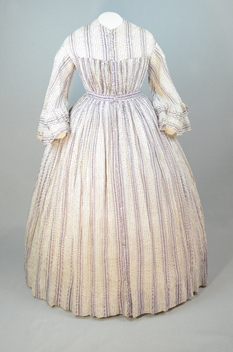
Figure 1 Housedress, white cotton printed with lavender, maker unknown, 1850-60 © The Irma G. Bowen Historic Clothing Collection, University of New Hampshire Library, USA, 100. Photograph by Astrida Schaeffer.
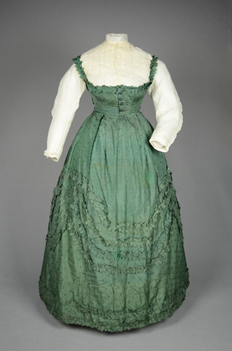
Figure 2 Dress, Green damask silk with integral Swiss waist over a cotton blouse, Lucinda Litchfield Smith, 1860-63 © The Irma G. Bowen Historic Clothing Collection, University of New Hampshire Library, USA, 55. Photograph by Astrida Schaeffer.
A sample of extant dresses, 1836-1845
Even the moderately wealthy, the cost of material could force women and their dressmakers to skimp on fabric allotment, and it is also likely that women were paying attention to other aspects of dress and not solely competing for the largest skirt circumference. Large skirts were impractical, after all; the smallest hem widths per era often belong to dresses intended for daily work. A case study of eighteen gowns made between 1836 and 1845 (Figure 3) will help to illustrate contemporary dressmaking recommendations and to what degree they were adhered to when planning new garments. This period, beginning the year that women’s sleeves lost bulk at the shoulder, was chosen to coincide with a publication that was published in 1838 and likely continued to influence both fashion and other publications for many years.
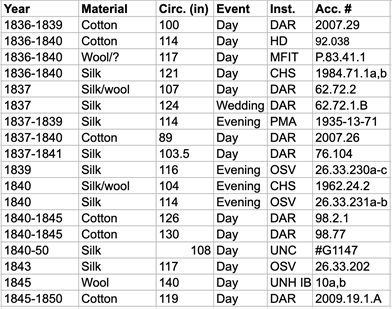
Figure 3 The eighteen-item sample, dating to the period 1836–1845, from museums and institutions on the east coast of the USA (see references for institutional acronyms). Columns are year (often a ‘circa’ date); primary construction material; hem circumference in inches; category of dress; holding institution; and accession or inventory number.
The selection of extant objects for this discussion was narrowed down to eighteen owned by museums and other heritage institutions on the East Coast of the United States which provided information online. Of these eighteen gowns, there is a mean hem circumference of 121.4” with a range of 89–140”. There is one wedding dress with provenance, three less formal day or work dresses, and three evening dresses with short sleeves. Six are cotton, eight are silk, one is wool, one is an unknown material, and the last two are wool/silk blends. All of the gowns containing wool seem to be a very light, fine weave like challis – in other words, high-quality fabrics.
Why do the hem sizes vary so much in a mere ten-year period? Given the rules of fashion, hems should have slowly risen from perhaps 120 to 140” during this time. But fashion was hardly the only rule by which people dressed in the nineteenth century, just as today; dress choices were guided by style, economy, and personal preference alike.
The simplest reason to deviate from fashion is that the dressmaker did not have enough fabric to make the full skirt. This could have been due to financial struggle or a general lack of material. While a bodice and narrow set of sleeves can be made out of a couple of yards of fabric, a skirt generally required more. Textiles were valuable, and piecing was common before the advent of ready-to-wear.2 The smallest hem in the set, on an 1837–1840 brown cotton print dress (DAR 2007.26), is only 89” and is made out of “three selvage to selvage panels plus two narrow panels at center back.”3 The incomplete nature of the panels indicates a lack of fabric, as it was preferable to leave the selvage intact where possible in order to eliminate additional steps of seam finishing. It is probable that these partial panels indicate either a lack of money to purchase more fabric or that this particular fabric was desired and not enough could be purchased. Economy might also have influenced gowns that used only full breadths of fabric. A printed cotton day dress c. 1840 (DAR 98.2.1), suitable for a working woman, has a 126” hem, while a more formal 1837 wool/silk blend gown has only a 107” hem (DAR 62.72.2). This might be a difference of date, but it is also a discrepancy that might be understood in terms of cost, as cotton was cheaper than silk and could be had in higher quantities. However, this concept deserves exploration beyond simple equations of cost. In an era where women wore multiple corded, starched petticoats in an effort to enlarge their skirts and historians expect to see a simple equivalency of more money to more fabric, what other factors might have influenced the size of an extant skirt?
The Workwoman’s Guide, 1838
For information about dressmaking in this era, we can look directly to a period publication. The Workwoman’s Guide, containing instructions to the inexperienced in cutting out and completing those articles of wearing apparel, &c. which are usually made at home was authored by “A Lady” and the book was first published in England in 1838.4 Extant copies are housed across Britain and America, and it is likely that the volume made its way over the Atlantic in time to be both relevant and useful to Americans of the era. Its anonymous author provides a surplus of information about an extended variety of garments, but only one paragraph specific to the making of gown skirts.5
These vary very much as to the number of breadths, according to fashion and material. Thin clinging materials, as muslin, require more breadths than thick or standing out articles of dress, as silk-gauze, velvet, &c.; six, seven, or eight breadths are worn now for full dresses, but formerly four breadths were deemed sufficient.6
This helpfully confirms that gowns should ideally have been made with full widths (breadths) of selvage–to–selvage fabric. At this time, skirts were generally long rectangles of fabric made from many smaller rectangles, each of which was the selvage-width by the waist–to–hem length with allowance for hemming. Thus, they were a fairly simple part of dress that did not require complicated drafting instructions, but they also depended fundamentally on the width of the fabric at the woman’s disposal, and on the qualities of that fabric. A stiffer, lighter fabric would create a wider hem; a heavier, softer textile would fold in on itself. This quote also neatly confirms that the hems were enlarging around this time, as she also cites an older, smaller style, probably from the early 1830s, as having given way to successively larger circumferences as hems widened and fell (Figure 4) (Figure 5).
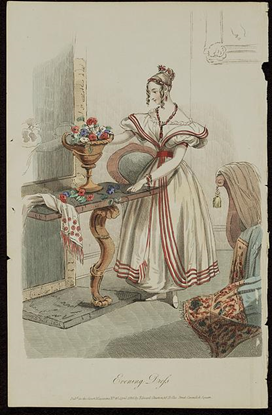
Figure 4 Evening dress, artist unknown, 1836, engraving, hand–colored, published in the Court magazine, no. 46, April 1836, © The Library of Congress, Washington, DC, USA LC–USZC4–5141.
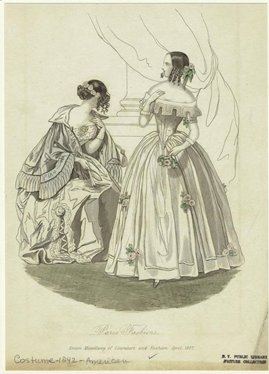
Figure 5 Paris Fashions: Boston Miscellany of Literature and Fashion, April, 1842, Artist unknown © The Miriam and Ira D. Wallach Division of Art, Prints and Photographs: Picture Collection, The New York Public Library, New York, USA 802212.
Textiles & loom widths
The anonymous author begins her book with a helpful series of notes on fabric, bringing up a second factor in our considerations of hem size. Silk, wool, cotton, and linen were woven on looms of varying widths, and fabric created on these different looms would necessarily lead to a variety of hem circumferences. Our author describes silks – taffetas and brocaded materials - being made in the smallest sizes, generally around 18”, and satins between 18-22.5” with costs of two shillings sixpence to seven shillings sixpence - far narrower and more expensive than cotton "prints, chintzes, and ginghams” which varied from threepence to one shilling at most, and for which “the usual width for gowns is 11 nails [24.75”]."7 Not only were cottons the cheapest – to be expected – but they came in the largest widths. It would be more economical to create a fashionably large dress out of cotton: a standard-width five–panel silk skirt would be 90” while a five–panel cotton skirt could measure up to 124” around. It is worth mentioning that a cotton skirt might require more fabric and support in order to have the same wide appearance that a silk skirt’s weave, weight, and body intrinsically provide, but several supportive and starched petticoats would have been worn under the dress either way.
The author also provides context around the kind of person who might be found wearing one fabric over another:
Those [gowns] commonly worn by servants, and the working classes, are of print, linen, stuff, and for best, light ginghams, merino, or bombazine; ladies wear muslin, gingham, silk, merino, and for dress, either lighter or richer materials, as satins, velvets, gauzes, &c.8
Generally, this list reflects that only ‘ladies’ wore silk and while all classes wore cotton and wool, the finer qualities (merino wool, cotton gauze, etc.) of these fabrics were too expensive for the working classes. The author advises for a dress suitable for a young working woman to be "made of the strongest print, at 8d. or 1s. per yard...in three breadths of extra–width print, of about eighteen nails [40.5”]."9 This refers to a more expensive calico and these measurements give a work dress with 121.5" at the hem. The 40.5” panels beat even the largest of the surveyed dresses’ panels, which are part of a white cotton fan–front summer dress (DAR 98.77) made with 37.75” wide panels and an overall hem of 130”. The book’s suggested 121.5” hem width and recommendation of calico are closer to a no–frills gown of dark printed cotton which is made of four panels of 31.5” cloth (DAR 98.2.1).
While partial widths (‘half-breadths’) could be used in a skirt, using full hem widths meant less seam finishing and fabric wastage and it follows that the unshaped10 skirts in this period would ideally have been made entirely of full selvage–to–selvage panels. Looking at the sample set, there is information about the number of panels that make up the skirts for thirteen out of the eighteen garments. The cotton gowns are made with either four selvage–to–selvage panels or three full panels and two smaller pieces, which indicates either a lack of fabric to complete a full fourth panel or a fabric–saving measure for wide cottons. The white summer dress c. 1840–1845 is somewhat of an outlier, as it is a finer cotton than the others and its high-quality muslin indicates leisure use rather than work. According to the author, a four–breadth gown was not particularly fashionable even in 1840, and she also advised for more fabric when using muslin. This evidence, applied to the white dress, points to a wearer who did not have enough money for a fuller skirt but wanted a luxury day dress nonetheless – or perhaps she was overtaken by the hustle and bustle of a new child and did not care enough to be perfectly fashionable in a gown outfitted for nursing.
The wool and silk/wool gowns are high-quality light woolens that draped well and sported fashionable patterns. The 1837 silk/wool gown with a 107” circumference is made up of three panels of 31”-wide fabric with two narrower panels hidden at back (DAR 62.72.2). It has a low neckline and was preserved with a pelerine, indicating that it was a multi–use dress. With the pelerine, it is suitable for daywear; without, for evening. The fabric might be the sort to be referred to as “stuff” by the author, noted as coming in “1/2 and ¾ yard, upwards [18–24”]. Price from 8d to 2s.”11 This would make it somewhat more expensive than the printed cottons, with the cheapest coming in around the same price as the most expensive ginghams, and the more expensive being twice the price.
The worsted wool gown dates to around 1845 (UNH 10a,b) and has a suitably large circumference in accordance (Figure 6). Its 140” hem consists of six 24” wide panels, the same width that the author mentions in her recommendation, and at six panels it comes in at the low end of her panel suggestions. By the book, this gown’s wearer was able to buy what she needed to be fashionable and cared enough to do so.
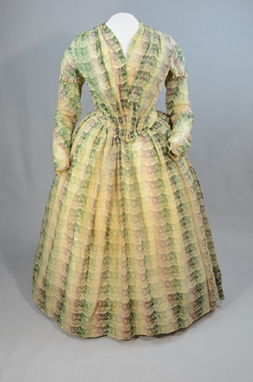
Figure 6 Fan–front dress, printed green and lavender silk and wool barege, lined with cotton, maker unknown, 1840s © The Irma G. Bowen Historic Clothing Collection, University of New Hampshire Library, New Hampshire, USA, 10a,b. Photograph by Astrida Schaeffer.
The silk gowns also consist of a range of weaves that can be ranked according to the Guide. Three appear to be of cheaper taffeta (brown and green; common in this region and era for cheaper ‘best’ dresses, as the DAR collections show); three are of ivory satin (well-represented in extant evening gowns); one is an olive and brown silk and velvet; and the last is of a pale green satin damask, lined entirely with a light buckram.12 The range of hem circumferences on these gowns is much narrower – 103.5” to 124” – and the four for which information on the panel layout was available were each made with six to seven panels of 16.75” to 21.5”-wide fabric. The gown with the narrowest fabric accordingly has the most panels. The four satin gowns are of a similar 1837–1840 style and vary the least out of the lot of eighteen. If the smallest gown of green taffeta had added another full panel of silk, it would have achieved a 121” circumference – perfectly acceptable, according to the other gowns – indicating that again, perhaps there was not quite enough money for that last yard’s length of fabric. This set is a good example of the standardization within a style and level of formality, given standard fabric widths; it is possible to extrapolate from here and expect other dresses of the same style and fabric to have been made in approximately this same way.
Body proportions
Our anonymous author provides one more reason that hem size might vary: the proportions of the body.
Broad hems and deep flounces also tend to lessen the height, it may therefore be taken as a general rule that tall persons should endeavor to add to their width, by making all the accompaniments to their dress as full and wide, as is consistant [sic] with the reigning taste, while those who are short, should let all theirs be as moderate as possible.13
If this advice was taken into account, we would expect that dresses with larger hems also have a longer waist–to–floor measurement (indicating a taller wearer), and smaller hems on dresses with a shorter waist–to–floor measurement (indicating a shorter wearer). This first requires that the dresses with the shorter–waisted 1830s style be separated from those with the longer–waisted 1840s style, and then garments within those categories be compared against one another. Unfortunately, this line of research did not bear fruit; the largest–hemmed dress is the bearer of one of the shortest skirts, and the smallest hem has one of the longest skirts. However, it is an aspect that these women may have kept in mind, and might bear true for different sets of data beyond this small sample.
While “A Lady” did not mention the width of the waist as a factor in hem size, other cutting guides and dressmaking manuals did.14 “Of course a stout person will require gores wider at the top where they are put into the waistband than a thin one,” one writer explained in 1875; and therefore “a stout person will necessarily require a wider skirt [hem] than a slim one.”15 Only ten of the garments in this sample had their original waist measurement listed. The range of sizes is 22-34” and the mean is 24.8”. While generally the measurements do not follow a clean, direct trend, it is notable that the largest hem by far – Figure 6, the wool dress with the 140” hem – also had the largest waist (34”), while the smallest-waisted garment (22”, cream wool, DAR 62.72.2) has one of the smallest hem measurements on the whole list of eighteen - only 107”. It is very possible that women followed advice on enlarging hems according to overall body size in both height and width.
Of course, these dresses are by no means perfectly representative of the female population around 1840. They are primarily of a sort that would have been commissioned and worn by wealthier women, though some are of poorer cloth, and they are all some measure of fashionable. Working dresses tend to be more generalized styles, more difficult to pin down by era. A single gown in the survey, UNC Costar #G1147, fits this description due to a complete lack of fashionable elements, but unexpectedly it is of six full widths of silk. Given the lack of provenance, a possible explanation for its simplicity is that it belonged to a Quaker woman. This would explain the larger hem circumference and the plain silk combined with a lack of decoration.1–15
All this is to say that while these gowns are not necessarily representative of the population at large, they may be more representative of the audience of books like The Workwoman’s Guide. The poorest and most hard–working of women might not have the money to purchase it or have wealthier friends to borrow it from, while the wealthiest of ladies would have no need of it, being able to pay for a dressmaker to do all of the work while pointing out the newest fashion plates in a magazine for design advice.<16 As the author herself states:
She is tendering an important...service to persons of her own sex, who, in any condition of life, are engaged...in cutting out wearing apparel in a family, or for their poorer neighbors. She trusts, in particular, the Clergymen's Wives, Young Married Women, School-mistresses, and Ladies' Maids may find, in the "Workwoman's Guide," a fast and serviceable friend. The patterns....to suit both rich and poor.17
1 These garments were donated by families who lived near the New Hampshire/Maine border. The curator suggests that the cotton gown was mostly likely worn by Mary Hoole Ffrost (1813-1882) of Durham, NH, while the silk was worn by Celestia Smith Freeman in Lewiston, ME, about 100 miles from Durham.
2 Philip A. Sykas, "Investigative Methodologies: Understanding the Fabric of Fashion," in The Handbook of Fashion Studies, eds. Sandy Black, Amy de la Haye, Joanne Entwistle, Regina Root, Agnès Rocamora, and Helen Thomas (London: Bloomsbury Academic, 2013), 235-68.
3 "Dress" (2007.26), Daughters of the American Revolution Museum, Accessed 1 December 2019. https://collections.dar.org/RediscoveryProficioPublicSearch/ShowItem.aspx?31630+
4 A Lady, The Workwoman's Guide, Simpkin, Marshall, and Co., London, 1840, The Internet Archive, Accessed 31 October 2019: 106. Using “A Lady” as a pseudonym had precedent for this type of work; the 1808 The Ladies’ Economical Assistant was authored similarly. Such publications were directed at professional and home seamstresses. Joy Spanabel Emery, “Development of Dressmaking Patterns, 1800-1860,” A History of the Paper Pattern Industry: The Home Dressmaking Fashion Revolution (Bloomsbury, New York, 2014), 19-20.
5 She does give information on how to make petticoat skirts, suggesting that two to two and a half breadths is appropriate for such an underlayer, "according to the width of the material of which they are made.” Ibid.., 104.
6 Ibid., 109. “Full” may refer to the level of formality (high) rather than the physical size or look of the dress. It does not necessarily denote silk evening dress; the author at one point uses this terminology to describe cotton gowns for working women.
7 Ibid., 13-14. One nail is 2.25", and 16 nails make a yard.
8 Ibid., 106. ‘Stuff’ refers to woolens; bombazine was a wool/silk blend.
9 Ibid., 110.
10 ‘Unshaped’ here indicating that rectangular rather than gored pieces of fabric were used.
11 A Lady, op cit., p. 13.
12 Of seven silk gowns dated between 1825-41 available online in the DAR collections, five were a variant of olive green or brown to golden brown, and one was ivory satin. In the survey here, of the eight short-sleeved formal gowns registered between 1830-1859, five are of ivory silk.
13 A Lady, op cit., p. 106
14 James Queen and William Lapsley, The taylors' instructor, or, A comprehensive analysis, of the elements of cutting garments, of every kind (Philadelphia, 1809), 63.
15 Abeille, “Home dressmaking,” Cassell’s Family Magazine (1875), 160.
16 Jo-Ann Citrigno, Needle Arts in Nova Scotian Women's Lives: 1752-1958, Ed. Jennifer Lambert, Curatorial Report Number 83, Nova Scotia Department of Education and Culture, 1998, p. 46, Accessed 31 October 2019, https://ojs.library.dal.ca/NSM/article/viewFile/4073/3728
17 A Lady, iii.
Overall, it is apparent that multiple factors besides fashion influenced the hem circumference of early Victorian gowns, which would be made with a certain number of full selvedge–to–selvedge panels of fabric unless circumstances dictated otherwise. Hem circumferences could reflect economic situation, social standing, and even body type. There is an expectation that the more wealth a woman had, the more fabric she would purchase to put into her skirt. But counterintuitively, because silks were woven so much narrower than woolens and cottons, it may not be unusual to find that a luxurious silk gown in a museum collection was made of less fabric than a casual day dress. These findings emphasize that multiple factors must be taken into consideration when analyzing historical dress, and that close looking at extant clothing provides necessary context to prescriptive literature and sewing manuals of the era.
None.
None.
Author declares that there is no conflict of interest.

©2024 Libes. This is an open access article distributed under the terms of the, which permits unrestricted use, distribution, and build upon your work non-commercially.